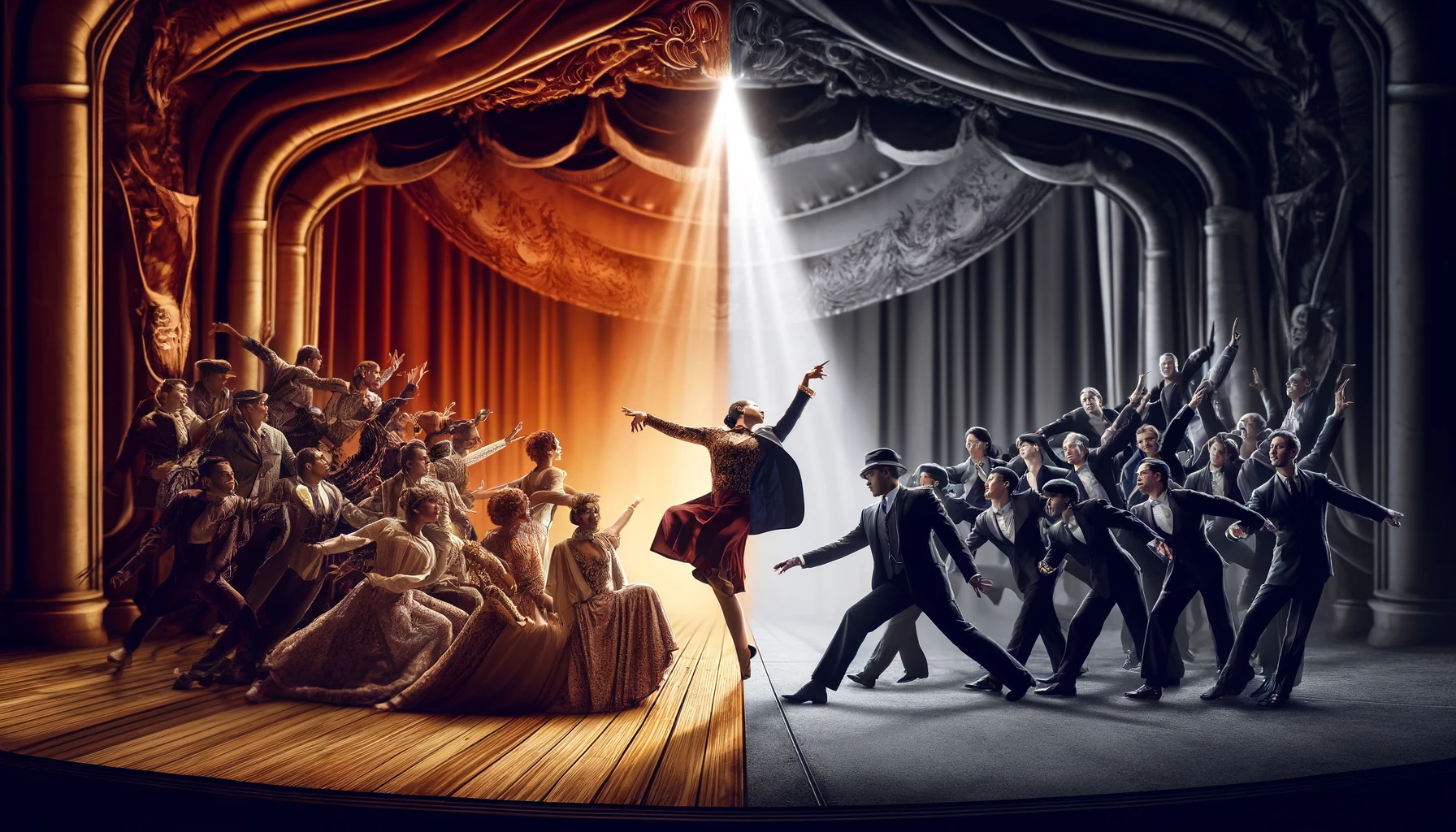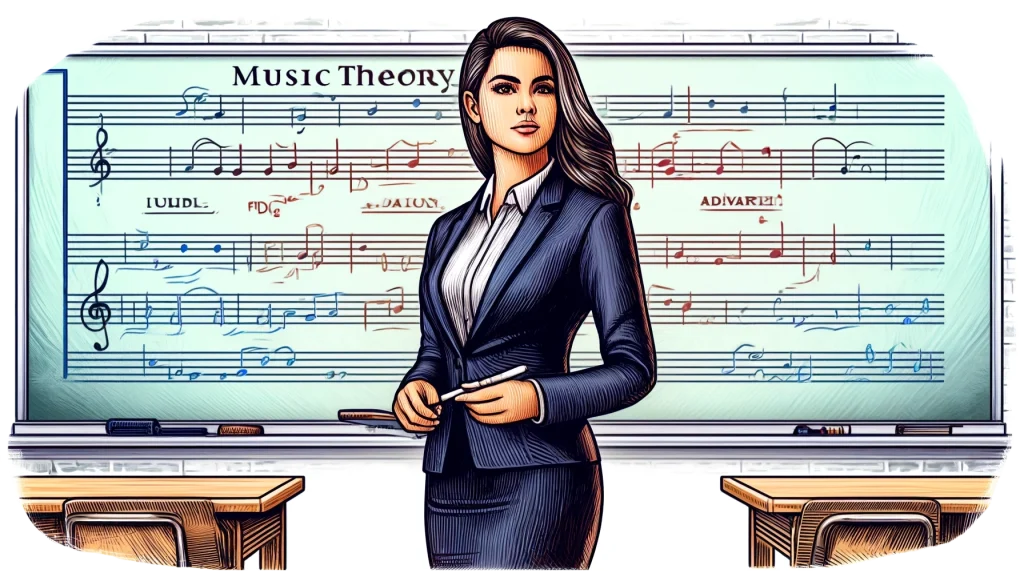In this modern age when academics seem to eschew most binaries, it may seem impossible to say what anything is anymore. In the music world, the distinction between musicals and operas is a thorny one that plagues music students, audience members, and professionals alike.
Attempts to define musicals as distinct from operas (or vice versa) tend to be all-too-easily undone with any of a number of counterexamples. While operas are usually sung-through and musicals usually contain dialogue, Die Zauberflöte contains dialogue, while Hamilton is sung (or rapped) throughout. Operas usually put the focus on music over story, whereas musicals do the reverse. However, there are many musicals (often classified more as musical revue), including most musicals before Oklahoma, that place the songs as the primary structural element, with only a loose plot to string them together.
While these genres may be resistant to absolute delineation, we can still discuss in meaningful ways the differences we expect between musicals and operas. Ultimately, there will always be exceptions if we say what musicals or operas are, but exceptions do nothing to undo our broader notions of what we expect musicals or operas to be. As Sondheim put it:
“Essentially, the difference, I think, is in the expectation of the audience. Obviously, there are differences in terms of performers and how they approach singing as an art form. But primarily an opera is something done in an opera house in front of an opera audience.” (source)
Let’s examine some of these differences in expectations between musicals and operas.
Language
Our first expectation that distinguishes musicals and operas is a question of language. As a primarily American invention, most well-known musicals are in English. Musicals are generally translated into other languages for performance worldwide. Most operas are in Italian or German. Many are also in French or English. Other languages are also used in operas, but translated operas are somewhat rare in modern performance.
Musical theatre audiences generally expect to understand what is sung to them, so it is usually in their native language. Les Misérables started as a French concept album in 1982 but was translated to English for the 1985 London premiere. (source) Phantom of the Opera was written in English, but has been performed in 15 different languages around the world. (source)
Operatic audiences generally expect to hear operas performed in their original languages. Translated operas are largely unheard of in the operatic world. Synopses are placed in programs to assist with comprehension, and libretti with translations are sold to be read during performances. In some opera companies, including many in the US, so-called “surtitles” or “supertitles” are projected above the stage with translations.
Music versus Text
In an insightful 2011 article Anthony Tommasini wrote for the New York Times, he summarized the difference between musical and operas this way: “…in opera, music is the driving force; in musical theater, words come first.” (source)
Again, taken in absolute terms, this distinction falls flat. In many modern operas, in the absence of common practice era tonality to provide structure, operas can be too deeply dependent on their stories to dismiss them as secondary in importance. Schoenberg’s Erwartung is dependent on the central character’s madness as a structural framework on which to hang the freely atonal writing. Heggie’s Dead Man Walking remains accessible despite the modern compositional idiom largely because of a deeply engaging, chilling story. The argument might even be made for some traditional works where the libretto was stronger than the music, but this is a fundamentally subjective matter. (I, for instance, found this to be the case with Puccini’s Manon Lescaut.)
However, if we take this distinction as a guide to audience expectation, it is deeply incisive.
Since Oklahoma set the trend in 1943 (though it was not the first musical to prioritize plot), most musicals are so-called book musicals, meaning that the script (or “book”) is primary and the musical moments are meant to emerge organically from the plot. While there are many noteworthy exceptions, including whole other classes of musicals – musical revues and concept musicals – audiences generally expect that musicals will follow the general conventions of book musicals and place the story at the center of the world of the musical. Understandably, many critics reviewing significant flops have pointed to the book as the primary issue.
In the operatic world, music is expected to be the featured attraction. This is best seen by looking at casting priorities and vocal technique.
Casting Priorities
Musical theatre directors often choose for individual shows and roles, between “actors who can sing” and “singers who can act.” In dance-heavy shows, they have even more difficult choices. While we celebrate the authentic triple threat, they are exceedingly rare and these types of casting choices are realistic ones that musical theatre directors face. Productions that demand too many triple threats (such as West Side Story, which calls for many triple threat teenagers) seldom if ever see performances where the whole cast really fits the bill, even on Broadway.
In the opera world, on the other hand, the expected first priority is to find great singers. While the days are largely behind us when opera could be a stand-and-sing sport, great singers who are middling actors can have robust careers. Opera singers are also nearly never expected to be strong dancers. Even in a cross-genre opera like Street Scene, the singer-dancers in “Moon Faced, Starry Eyed” are often musical theatre imports.
Vocal Technique
One of the easiest-to-observe differences in our expectations between opera and musical theatre is the style of singing. As with all expectations, these have changed over time.
Currently, musical theatre is favoring a bright, forward sound that is influenced by pop singing. However, regardless of the time period, musical theatre has generally made clarity of text a priority. This includes the aforementioned translation of musicals and the expectations we have for the singers, but many of the burdens of our expectations fall to the composer. For musical theatre composition, good prosody, reasonable vocal ranges, clear rhymes (usually perfect rhymes and identities), and an understanding of vocal technique and capabilities are prized for allowing textual intelligibility. (Good prosody refers to using musical accentuation that is in line with the natural accent patterns of regular speech.)
Opera, on the other hand, often places timbre above intelligibility, making it necessary, for instance, for English-language operas performed for English-speaking audiences to still use projected supertitles to aid with comprehension. Similarly, composers have more liberty to distort the text with long melismas, sometimes questionable prosody, and writing in extreme ranges where textual clarity suffers.
Even when musical theatre singers take on a more classical technique in so-called “legit” singing, textual clarity remains important. And while some singers are able to navigate the boundaries between musical theatre and operatic technique, including musical theatre singers like Audra McDonald and opera singers like Kiri Te Kanawa, it is usually clear when their sound is more like what we expect in opera as opposed to what we expect in musical theatre.
For detailed coverage of operatic versus musical theatre singing techniques (including discussion of different types of musical theatre techniques, like belt vs. legit vs. mixed), consider reading Johann Sundberg’s article “Comparison of Pharynx, Source, Formant, and Pressure Characteristics in Operatic and Music Theater Singing” from the Journal of Voice (vol. 7, no. 4, 1993).
Orchestration
Another difference between musicals and operas is albeit a subtle one: instrumentation and orchestration (which instruments are used and how the music is written for those instruments).
Operas are typically orchestrated by the composer, usually feature all or nearly all acoustic instruments, and are usually stylistically similar to the style of concert music of their times. Doublings (when one player is asked to play more than one instrument) are usually restricted to standard orchestral doublings, such as having the flutist also play piccolo and possibly alto flute. When percussion is included, operas tend toward orchestral percussion instruments and seldom use a drum set. The backbone of these orchestras are often the strings, though more variety is introduced in contemporary operas.
In musicals, the composer is seldom also the orchestrator. A separate orchestrator is usually commissioned to take the piano-vocal (or even just fake book) score and orchestrate it for a pit orchestra. Unlike in operas, musicals often include electronic instruments, call for extensive doublings, usually place the piano/keyboard in a central role, and tend toward the drum set as the first choice of percussion instruments. One electronic instrument they especially favor in modern musical theatre orchestration is a keyboard that is programmed to produce many orchestral sounds, creating the illusion of a much larger and more diverse pit orchestra. As for the doublings, the most extensive of these are typically given to the wind players, who are usually listed in the score as “reed” players. A “reed” player typically plays several wind instruments, including ones that orchestral players (including in opera orchestras) would almost never be called upon to double. Consider the doublings, for instance, of the Reed 3 part in West Side Story: Bb Clarinet, Bass Clarinet, Bari Sax, Tenor Sax, Flute, Piccolo, Oboe, and English Horn. (source) That’s just for one player! (See this site for a catalogue of woodwind doublings in various musicals.) While musicals do tend to favor drum set over orchestral percussion, the drummer often expands his traditional kit with some ancillary percussion instruments and, in some cases, a second player plays just orchestral percussion. (The percussionist in West Side Story plays over 25 different instruments, for instance; source).
When Musicals and Operas Collide
Musical theatre and opera continue to have blurry boundaries. While modern musicals are usually more willing to embrace and appropriate popular styles of the day, operas have taken part in this too. On the other hand, operas have been more willing to forgo dialogue with sung-through works that distinguish between conversational recitative and more deeply beautiful and reflective arias, but many recent musicals have borrowed heavily from this convention, even when they still retain spoken dialogue.
Moreover, a number of musicals (including West Side Story, Sweeney Todd, Carousel, and Showboat) are performed by opera companies and several operas (such as La Bohème, Madame Butterfly, and Aida) have been adapted into successful musicals. However, in the performances of musicals by opera companies, our fundamental expectations as audience members change for what we will experience in the theatre. Sometimes these differences are extreme, such as hearing the first generation American of Polish descent, Tony, sung on the 1984 operatic recording of West Side Story by José Carreras, complete with Spanish accent (ironically made even more jarring by having his lines read by an actor with an American accent).
And while many concert music composers have embraced fusion of opera with jazz and various popular styles, some musical theatre composers have adopted contemporary concert music idioms. For example, Michael John LaChiusa’s See What I Wanna See is classified by the composer as a musical, but in many sections, its angular melodies and harmonic language are more akin to contemporary chamber operas.
Despite these sometimes blurry boundaries, our expectations for these works remain largely intact. For instance, while the compositional style of much of See What I Wanna See may run contrary to our expectations for musicals, it is still scored for a combination of acoustic and electric instruments, includes drums, and includes two “reed” players (source); most of the singers in it adopt a production more appropriate to musical theatre singing and allowing for clear comprehension of text; the story is central to the writing; and the musical is sung in English for an English-language audience.
The Difference Between Musicals and Operas
We must recognize the differences in expectations of writers, performers, and audience members in these musical-dramatic genres. Pretending that these lines cannot be drawn runs contrary to experience and is unnecessarily prescriptive. Understanding these differences in expectations enriches our understanding of both genres and both performances traditions. It can also help audience members make sense of their different responses to the genres. On the creative end, identifying differences can even help us demarcate the very boundaries we may wish to blur. This blurring and borrowing has the potential to continue to enrich both musical-dramatic genres and lead to the creation of many new great operas and musicals.
Comments?
Please share your thoughts and comments! What are some of the differences between our expectations for operas and our expectations for musicals that I did not include above? What musicals or operas blur the boundaries so much that they defy ready classification and don’t entirely fall within our expectations for either genre?
©2017 Aaron Alon. All Rights Reserved.











Check out the American operetta ROSE OF THE DANUBE, the 1934 masterpiece by Arthur A. Penn (music). and Geoffrey F. Morgan (book, libretto and lyrics). The copyright is still owned by Carl Fischer, LL.C., INC. of NYC and the script and piano score is available on-line for copying in accordance with current copyright law from the Sibley Library of the Eastman School of Music of the University of Rochester.
It was the “rite of passage “ in many schools in the USA and Canada during the 1930’s, 40’s, 50’s, and 1960’s. It was also an integral part of the “little theater movement,” and staged by many university drama groups of the time.
Arthur A.Penn was a naturalized USA citizen originally from London, UK. He and his wife lived quite well on the royalties of the iconic song, which he wrote the lyrics and the music for in twenty minutes called:“Smilin’ Through.” He was a real curmudgeon and frequent letter-to-the-editor of the NEW YORK TIMES writer. He was a direct descendant of Pennsylvania founder William Penn.
Geoffrey F. Morgan was true ‘Renaissance Man” and also a naturalized USA citizen also born in London, UK. He was a noted Chautauqua speaker, a graduate of Stanford (AB) and Columbia (MA), a State Superintendent of Schools, and a CA State Assemblyman from Santa Monica.
This operetta gem deserves to be saved from obscurity with future productions and much more research.
This operetta needs a full scale revival with dancers doing all types of dances, and full orchestrations, which can be copied from the Library of Congress by ad hoc non-employees of the L of C.